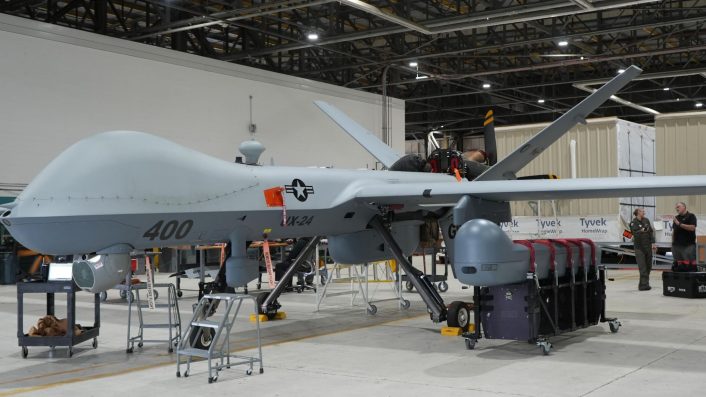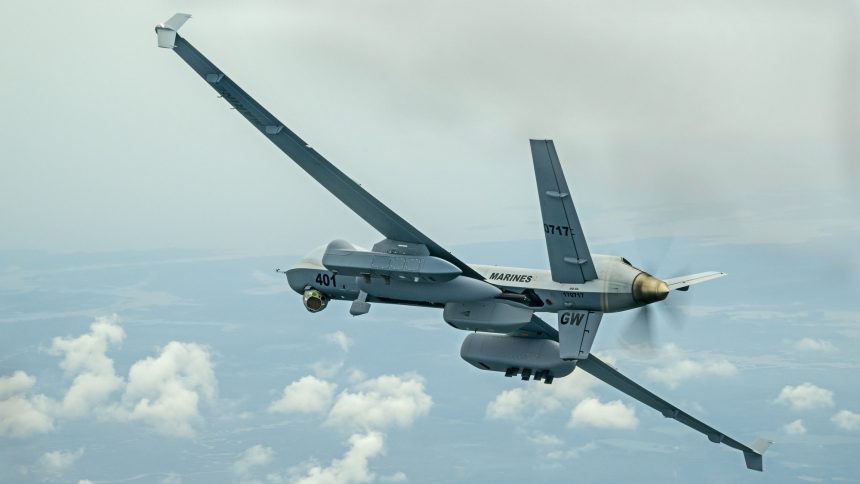NAVAIR announced the first flight of the unmanned aircraft with new electronic support and enhanced cross-domain comms.
In a post on social media, the Naval Air Systems Command (NAVAIR) announced the first flight of an MQ-9A Reaper, assigned to Air Test and Evaluation Squadron (UX) 24, equipped with the SkyTower II and RDESS/SOAR pods. The Command defined this as a critical step toward Initial Operational Capability (IOC) later this year.
The pods’ names were explicitly mentioned, with only their capabilities mentioned, however they are clearly visible in the accompanying image. In fact, the image shows the MQ-9 equipped with the SkyTower II pod and an external fuel tank under the left wing and the RDESS/SOAR pod under the right wing, together with a still unknown pod on the centerline which might hosts the communications relay capabilities of the U.S. Marine Corps’ Reapers.
The MQ-9 Reaper just flew its first flight with new electronic support and enhanced cross-domain comms. This advancement is a critical step toward Initial Operational Capability later this year, ensuring this unmanned aircraft brings unmatched Lethality and Readiness to the fleet pic.twitter.com/4456HhE1Sk
— NAVAIR (@NAVAIRNews) August 12, 2025
No additional details have been provided, and it is unclear when the first flight took place. Previously, NAVAIR announced that in February 2025 UX-24 loaded the new SkyTower II pod onto the aircraft for the first time and conducted initial power on checks.
SkyTower II
The SkyTower II pod is an airborne network-extension pod developed to significantly enhance cross-domain communications and data sharing across disparate forces. Designed by GALT and integrated via NAVAIR’s middle-tier acquisition approach, it’s set to deliver its initial operational capability soon.
NAVAIR says the pod is required to execute the Intelligence, Surveillance, and Reconnaissance (ISR) concept of operations by providing tactically relevant operational communications and data sharing capabilities with many forces in support of the MQ-9 Reapers’ operational mission. SkyTower II enables MQ-9s to act as airborne “digital quarterbacks,” serving as vital ISR and communications relay platforms, a capability especially critical for U.S. Marine Corps operations in the Indo-Pacific’s expansive and contested environment.
UX-24 loaded the new pod onto the aircraft on Feb. 25, 2025, conducting initial power on checks, the first step into integrating the new capability into the aircraft platform. Back then, NAVAIR mentioned that, over the next several months, UX-24 was scheduled to conduct final test events before delivering the upgraded MQ-9s to the fleet.
Marine Unmanned Aerial Vehicle Squadron (VMU) 3, based at Marine Corps Base Hawaii, Kaneohe Bay, will be the first to deploy with this new system on its MQ-9s in 2026. VMU-3 has a pivotal role in advancing Marine Corps capabilities in reconnaissance, surveillance, and target acquisition missions across the Indo-Pacific region.

RDESS/SOAR pod
The RDESS/SOAR (Reaper Defense Electronic Support System/Scalable Open Architecture Reconnaissance) is not really new to the Reaper, as it has already been spotted on VMU-3’s MQ-9s. Developed by General Atomics and L3Harris, it was first initially tested by the Air Force in 2021, but it is not clear when the Marine Corps acquired it.
General Atomics describes the system as a broad spectrum, passive Electronic Support Measure (ESM) payload designed to collect and geo-locate signals of interest from standoff ranges. This allows the Reaper to conduct electronic sensing and communicate actionable intelligence.
Additionally, the pod has the ability to make the MQ-9 “mostly undetectable,” according to Gen. Eric M. Smith, the Commandant of the U.S. Marine Corps. “[The pod] can mimic, I’ll be careful here, it can mimic things that are sent to it that it detects, turn it around and send it back,” stated Smith without further elaborating because of security reasons.

The MQ-9’s role in the USMC
As part of the 2022 Marine Corps Aviation Plan, the Marines plan to use MQ-9As “with a suite of add-on pods to support the Marine Littoral Regiment as the stand-in force. The aircraft will provide Intelligence, Surveillance, Reconnaissance and Targeting (ISR-T) as well as performing additional missions such as Maritime Domain Awareness (MDA), Airborne Network Extension (ANE), Airborne Early Warning (AEW), and Electronic Support (ES).”
This is part of the new concept of operations being adopted by the service, enabling expeditionary operations in maritime environment with a lighter but yet lethal force, exploiting information superiority and new technologies. The MQ-9 is a key part of this strategy, as it operates above Marine and Navy units, providing intelligence, surveillance, reconnaissance, targeting, communications, networking, and more.
Specifically, the Marines are acquiring the MQ-9A Reaper-ER (Extended Range), which maximizes the endurance of the platform and extends it to more than 30 hours. In the vast area of the Pacific, this is an aspect of primary importance, meaning the aircraft can easily cover the long distances it might need to travel over water and provide persistent surveillance.
NAVAIR adds that the “MQ-9 Reaper provides Marines with a long-range ISR capability in support of maritime domain awareness and expeditionary advanced base operations in contested environments.” The USMC announced that the MQ-9A Reaper reached IOC with the VMU-3 on Aug. 2, 2023.









